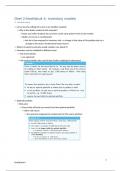Deel 2:Hoofdstuk 4: inventory models
1. Introducti on
-> Let us start by setting the scene in an intuitive example
-> Why is the dealer needed in this example?
-> buyer and seller (traders) do not arrive at the same point in time in the market
-> dealer can serve as counterparty
-> but he is then exposed to inventory risk = a change in the value of his position due to a
change in the asset’s fundamental value (news)
-> What is inventory and why would a dealer care about it?
-> Inventory can be modelled in different ways
-> risk-averse dealer
-> our approach
-> risk-neutral dealer who can fail (see further reading for references)
-> Optimal portfolio
-> Risk avers
-> Every trade will push you away from that optimal portfolio
-> Other risk return
-> the spread is supposed to compensate for the worse position
1
Hoofdstuk 4
,-> selling more attractive: higher your bidprice
-> Buying less attractive; higher ask
-> Interdealer market
2. Not
2
Hoofdstuk 4
,3. A model of inventory Risk
3.1 Model Setup
-> 2-period model, where the periods are denoted t = 0 and t = 1 (no discounting)
-> Think of it in seconds
-> N risky assets, indexed by subscript i = 1, ..., N, and one risk-free asset which we call cash
-> One dealer
-> risk-averse
-> Because we need them to care about inventory
-> Other risk return profiles
-> competitive
-> Dealer enters t = 0 holding his optimal portfolio (investment account): q*i,0 units of asset i and an
amount c0 in cash
-> q*i,0 > 0 means a long position, q*i,0 < 0 a short position
-> return on cash is the risk-free rate R f which we set to zero
-> Observed fundamental value in t = 0 of asset i is V i,0
-> V : fundamental/true value of the asset
-> Traders and dealers now the true value
-> Value in t = 0 of dealer’s optimal portfolio W0 is equal to
-> sum (Position of each asset x the value of each asset (risky asset)) + the amount of cash he has
-> We call W0 also initial wealth, the wealth with which the dealer enters period 0.
-> We now consider two possible cases
1) dealer does not receive an order from a trader in t = 0
2) dealer does receive an order that he needs to execute as counterparty to the trader
-> Dealer simply keeps his optimal portfolio until t = 1
-> Assume that at t = 1, the payoff of each asset i is Ṽi
-> tilde denotes a random variable, we don’t know what the asset will be worth the next
periode
-> we assume that the beliefs of the dealer on the distribution does not change over time, so
we do not use a time subscript
-> this is in contrast with e.g. information-based models where a dealer update his beliefs
after a buy or sell trade
-> note: this is not the fundamental value, see later
3
Hoofdstuk 4
, -> Dealer’s wealth at t = 1, called terminal wealth, is then
-> Terminal wealth
-> is a random variable since the payoff is
-> is determined by value of optimal portfolio, i.e. by the investment account (risky assets+
cash)
-> Assume that the dealer makes only one transaction per trading interval; after the trade, we move
to period t = 1
-> Traders can only submit market orders (no limit orders)
- > Size of the trader’s order is xi,0 units of asset i (traders perspective)
-> xi,0 > 0 means that the dealer receives a buy order (thus dealer sells)
-> xi,0 < 0 means that the dealer receives a sell order (thus dealer buys)
-> Trade makes him deviate from his optimal portfolio = dealer’s inventory or trading account
-> Not as the number of assets that he has, but as an deviation from its optimal portfolio
-> 1000 - 100 = 900, his inventory is -100, because 1000 is his optimal stock q*
-> Denote the price, quoted by the dealer for a transaction of size x i,0 as pi,0
-> The dealer’s terminal wealth is
-> Terminal wealth is now determined by the combination of his investment account and his
trading account
-> The first part is what you have when you don’t make the transaction
-> Ṽixi,0 gives the impact of the trade on the position in asset i
-> The minus is there because x is from a traders perspective
-> pi,0xi,0 is the impact on the cash position of the dealer
=> When you’re selling and I’m buying, the cash will go down, but our inventory will go up (2de
term will be positive and the 3de will be negative)
-> Price is gonna depend on the order size
4
Hoofdstuk 4




